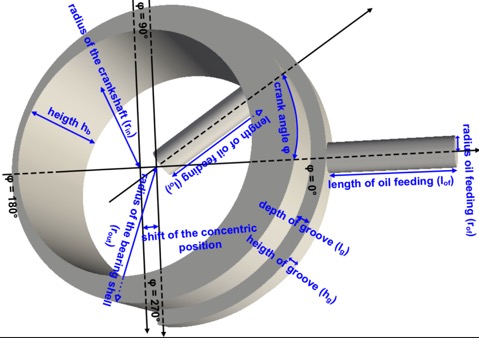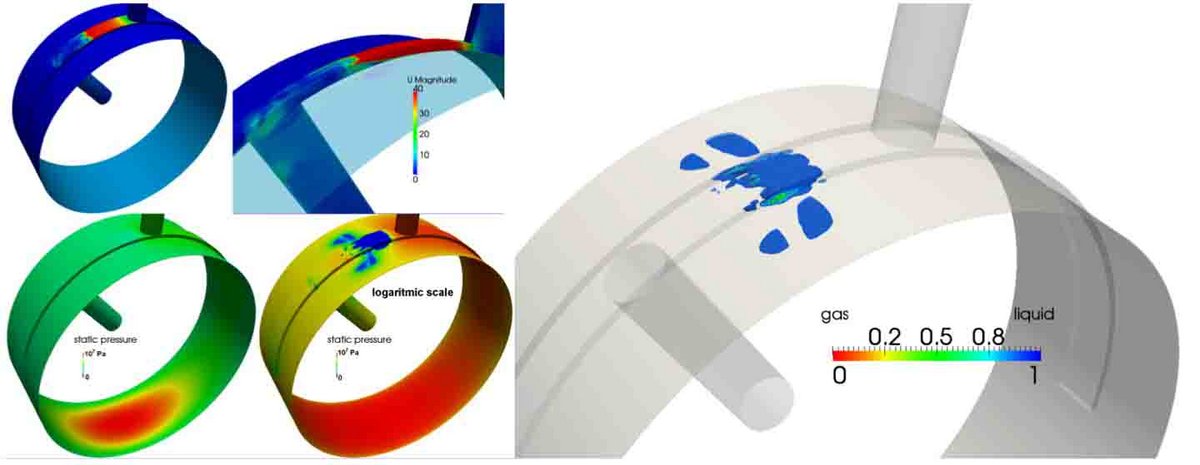Fluid Mechanics
3D-CFD-Simulations of journal bearing flows
Several types of cavitation are known in a dynamically loaded hydrodynamic journal bearing, caused by a sudden displacement of the shaft, local disturbances due to the cross flow of the oil feedings, geometric features like sharp edged grooves or combinations thereof. Up to now, just experimental and theoretical methods based on indicators of cavitation are used to investigate the causes of cavitation. But there are neither systematic nor verified investigations concerning the identification and quantification of these causes of cavitation in a dynamically loaded hydrodynamic journal bearing. Very common for the calculation of the lubricating film are efficient, fast and approved two-dimensional solvers for the Reynolds equation resulting from the simplified Navier-Stokes equations. These 2D-methods resolve the lubrication film in circumferential and axial direction and thus neglecting 3D-effects in radial direction caused by lubrication pockets and oil feed holes. These local disturbances are responsible for the onset of cavitation. This project aimed to resolve such regions by using a three-dimensional CFD approach.
As Figure 1 shows we consider Couette flow in an annular cavity with a fixed outer cylinder which is completed by a 180° groove. The inner and the outer cylinder have oil feed holes supplying the system with oil. Due to the implied offset track of the rotating inner cylinder there is no axial symmetry.
The simulations were done with a two-phase solver that is capable to compute phase-change and the mesh movements for the offset track and rotating inner feed hole. The oil and vapour phases are described by the volume of fluid method. Both phases have a constant temperature and assumed to be incompressible. The Navier-Stokes equations were solved for the phase mixture of oil and vapour. Both phases can be distinguished by the volume fraction which requires an additional transport equation to close the set of equations, whereas a simplified Rayleigh-Plesset computes the phase change.
This solver was developed in several steps in each another validation method has been used. The validation of the module responsible for the offset track was done with a Taylor-Couette system with the rotating inner cylinder moving on an orbit starting from the concentric position.
Due to this idealised offset track the local gap geometry changes in time and thus influences the flow state. A locally smaller gap reduces the local Reynolds number causing the decay of the Taylor vortices. Validation of the module that simulates the rotating inner oil feed hole was done with a bearing flow experiment of the HAWK of Göttingen (Prof. Peter Reinke). The results can be seen in Figure 2 where a qualitative and a quantitative comparison of the numerical simulation and the experiment is shown.
The complete numeric solver implying offset track, crossflow through oil feedings and phase change was applied to simulate a journal bearing of the experimental work of Wollfarth [1]. This experiment was a designed test bay to investigate cavitation in journal bearings. The simulation has been carried out for an 1 permille gap, 2000 rpm of the 5 mm diameter crankshaft and a crossflow of 40 l/min. Figure 3 shows a screenshot at 43° crank angle during the starting process including strong displacement (squeeze) effects [2].
Bibliography:
- Wollfarth, M., "Experimentelle Untersuchungen der Kavitationserosion in Gleitlagern“, Dissertation, Universität Karlsruhe, 1995
- Egbers, Ch., Gorenz, P., Schmidt, M., Wolf, C., 2015, 3-D-CFD-Simulation der Schmierspaltströmung in einem Radialgleitlager, MTZ - Motortechnische Zeitschrift, June 2015, Volume 76, Issue 7, pp 66-73, ISSN 2192-8843



